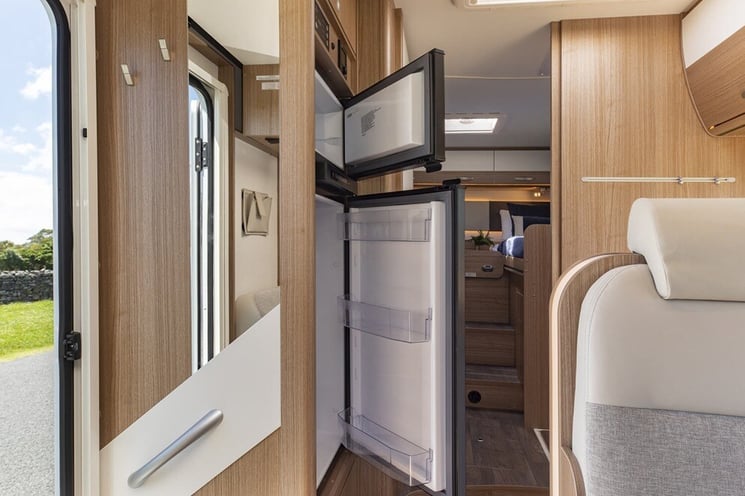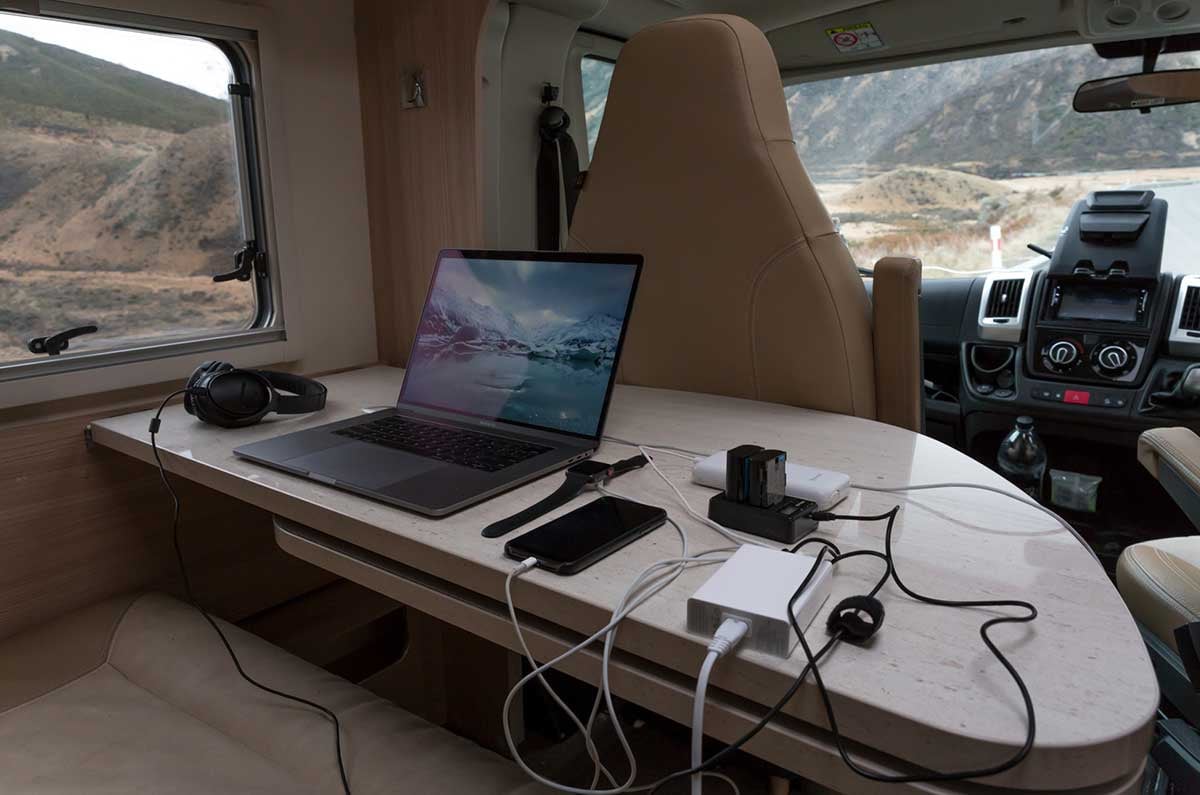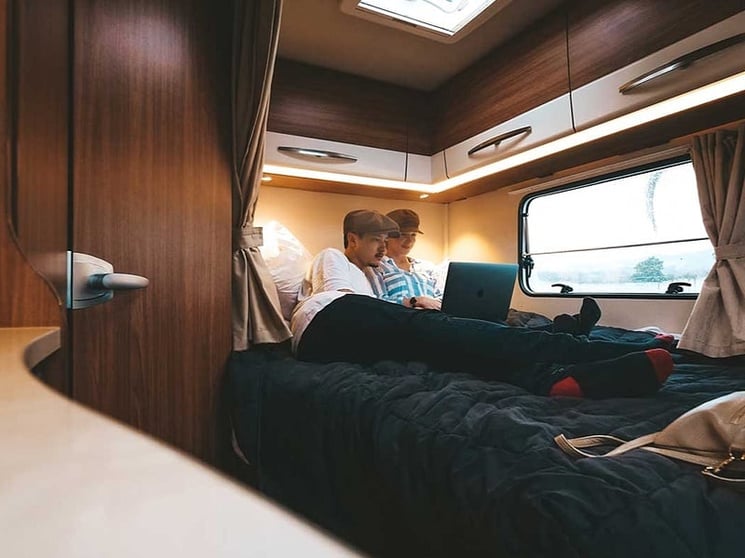Whether you prefer freedom camping, staying at powered campsites, or a combination of both styles of camping, it’s important to know how you can get power in your motorhome. Here’s our quick and easy introduction to motorhome power including how the power supply works, how you can use power without plugging into mains, how much power you can expect to use and how often you'll need to plug in.
|
Contents |
How does the power supply work in a rental motorhome?
Motorhomes have power sockets and switches like the ones you have at home. The sockets have an angled two or three pin plug - the same as used in Australia and in parts of Asia. To get power to the sockets, you need to be connected to a power source. Most motorhomes have three main power sources in addition to the engine battery: 240 volt mains power, 12 volt house or leisure batteries, and gas (LPG or propane). The engine battery is simply there to start your motorhome engine while the other power sources run all the onboard appliances, provide heating and hot water, and power any devices you bring along.
The 240 volt mains power system works when you connect to a power box at a campground. It will power all the onboard appliances and any electrical equipment you bring with you. The 240 volt system also charges up the house battery. .png?width=900&name=240v%20power%20plugged%20in%20(1).png)
Wondering if you can connect your motorhome to a domestic power supply to charge up your leisure battery?
The answer is no. It’s neither legal nor safe. That’s because your home runs on a 10 amp power supply and motorhomes and caravans run on a 15 or 16 amp supply. If you try to connect your motorhome to a house using a standard extension cord, you will overload the socket and meltdown both the power point and the extension cord plus cause a fire hazard. You need a motorhome or caravan power adaptor to safely connect to any power supply other than the one in the holiday park. An approved adaptor, available from most RV supply stores and many hardware and camping stores, has a circuit breaker which limits the amount of power the motorhome or caravan can use to 10 amps. You can buy either an indoor or outdoor rated adaptor. |
How does a motorhome work without mains power?
When you’re off grid, the power system works differently. Pretty much everything electrical in your motorhome will work when you’re hooked up to mains power at a campsite. But when you’re not, some of the onboard appliances may not work. Neither will the equipment you want to plug in to the power points. That’s why motorhomes have alternative power sources.
When you’re not connected to 240 volts mains power at a campsite, you will use the house battery or gas. The house battery works while you’re driving and both the gas and house battery work when you’re parked up.
The house battery system, also called 12 volt system, supplies power to the living area. This is designed to provide power to the main appliances and equipment when you’re not hooked up, such as the lights, fridge and water pump, as well as starting the central heating system.
The 12 volt system is not as powerful as the 240 volt system (that you will use when hooked up to mains power) so it can’t run all the appliances and equipment. The table below gives examples of what appliances and equipment will work on the different power sources.
|
Motorhome appliances & equipment |
Campground |
Off grid |
||
|
Mains power (240V) |
Leisure battery (12V) |
Inverter connected to leisure battery |
LPG |
|
| Refrigerator (3-way) |
x |
x* |
|
x |
| Gas cooker |
|
|
|
x |
| Microwave oven |
x |
|
|
|
| Central heating / hot water |
x |
x |
|
x |
| Portable heater |
x |
|
|
|
| Electric toaster |
x |
|
|
|
| Water pump |
x |
x |
|
|
| Lights |
x |
x |
|
|
| TV/LCD screen |
x |
x |
|
|
| Charging personal devices e.g. laptop, mobile phone, iPad, digital camera |
x |
x |
x |
|
| Personal appliances** e.g. hairdryer, hair straightener, curling iron, shaver, electric toothbrush, CPAP machine |
x |
|
x** |
|
|
*Only while engine is running **Depends on rating of inverter. A basic inverter can supply appliances up to 600W which may be insufficient for some hairdryers, straighteners, or curling irons. |
||||
*Depends on rating of
Some personal devices, such as a CPAP machine, may be rated for 12V so may work when connected to the leisure battery via a cigarette lighter socket.
|
Microwaves Many luxury rental motorhomes don’t come with a microwave. That’s because they’re usually designed for staying off grid and microwaves only work when connected to mains power. Also, premium motorhomes often have a small kitchen as a greater portion of the living space is taken up with the permanent bed(s). Since a microwave takes up a lot of space and can’t be used without mains power, they’re usually not fitted in a high-end motorhome. If you want to travel light and plan to freedom camp, you may want to consider leaving at home any of the personal appliances that only work when the motorhome is connected to mains power. |
The leisure batteries need to be charged up frequently to enable the 12 volt system to keep working. Although the batteries will charge while you’re driving, plugging into mains power is the best way to fully charge them.
The gas system is powered by LPG or propane. The gas bottles are stored in a ventilated external locker which is separated from the living area for safety. The gas system powers the gas cooker plus the refrigerator (3-way type), hot water heater, and the central heating unit, if the motorhome has one. The gas bottles must be manually turned on to operate the gas appliances and turned off after use. It’s important to ensure the gas bottles are turned off before starting the motorhome and when the motorhome is on the inter-island ferry.
The fridge is one appliance that you’ll want to ensure has power at all times. That’s why the fridges in motorhomes work off different power sources depending on whether you’re driving, freedom camping, or hooked up to mains power at a campground. The fridges in many premium motorhomes can switch automatically between three power sources (12V house battery, 240V mains, and gas). However, a few models require you to switch manually.
The fridge will generally run on the 12 volt house battery while you’re driving. As soon as you stop driving, you need to either hook up to mains power or turn on the gas. As the 12 volt system is not as efficient as the 240 volt system, it will just maintain the fridge temperature rather than lower it. So, it pays to turn on the mains power and make sure the fridge is running on the 240 volt system as soon as you stop at a powered campsite to get your drinks and food nice and cold.
If your campsite doesn’t have power, the fridge will run off gas as soon as you turn on the gas bottles. Always check that the fridge has switched to gas mode when you freedom camp to make sure all your food stays nice and cool. Even if you stop for more than an hour, it’s worth turning the gas on so the fridge is cooling.
Many budget motorhomes have smaller fridges that tend to run on only two power sources: the 12 volt house battery or mains power. If the house battery is charged up, these two-way fridges may be suitable for short periods of freedom camping.
Some premium motorhomes have an additional feature called an inverter, which allows you to operate some equipment from the 12 volt house battery. It’s a good idea to look for a motorhome with an inverter especially if you’re planning to stay off grid. An inverter is a handy inbuilt device that converts power from the 12 volt house battery to 240 volts when you’re not plugged into mains power. The motorhome will usually have one power point that’s connected to the inverter. Plug your phone, camera, iPad or laptop into this power point to charge it when you’re not hooked up to mains power.
Be aware that charging too many devices continually will drain the house battery, eventually. Also, a basic inverter can’t handle appliances that draw more than 600 watts such as some hairdryers, straighteners, or curling irons.
|
💡 Playing Music The cab head unit (radio) may be wired to the house battery so you can listen to music from your device via Bluetooth when the engine is turned off. It will drain the house battery, however, so turn it off when not in use. |
How much power does a motorhome use?
The most important job of the house batteries is to power the main appliances in the living compartment (fridge, lights, water pump, and to start the central heating and hot water heater) when you’re not hooked up to mains power. If you only used your house batteries to operate these and drove your motorhome for an hour or two each day, your batteries should last without needing to hook up mains power. However, it’s all the other equipment of modern living that drains the house batteries.
To figure out how much power you will use for the additional equipment (such as the entertainment system and your personal appliances and devices), consider how many people are onboard and how many appliances and devices they are using. It also makes a difference whether you’re travelling in summer or winter. In the cooler weather, we spend more time inside watching movies and charging devices. If we take longer showers, the water pump will run for longer.
You can monitor how much power you’re using by keeping an eye on the battery levels on the main control panel. Different motorhomes have different displays but usually they will have an indicator with a green, orange and red light. The orange light means the battery needs to be topped up. Driving for a few hours will usually be sufficient to top up the batteries at the orange level. Once you hit the red level, you will need to fully recharge the batteries. The only way to do this is to plug into 240 volt mains power overnight.
If you plan to spend time off grid, you can maximise the available battery power by using a few our team’s top tips:
- Make sure your devices are fully charged before you set off on your road trip.
- Charge your devices while driving or when you’re plugged into mains power.
- Turn off equipment such as the lights, water pump, and the inverter (if your motorhome has one) when not in use.
- Ask the rental operator to plug the motorhome in overnight before you collect it. That way, the fridge will be cold when you put your food and drinks in and you don’t need to use a lot of power cooling the fridge.
- Reduce the number of times you open the fridge door. Every time you open the fridge door, you allow warm air to warm the fridge.
- Use the entertainment system sparingly. The LCD screen uses a lot of power. Save the binge movie watching for the nights you’re hooked up at a powered site. Try other nighttime activities that require little or no power, such as playing board games or star gazing instead.
- Extend the charge on your phone battery by turning it off or switching to flight mode when you’re in an area with poor reception so the phone isn’t constantly trying to reconnect to cellular service.
The cigarette lighter in the cab is useful for charging your phone while driving but it is not powerful enough to charge an iPad or laptop.
The fridge is the appliance that renters most often have trouble with. Make sure familiarise yourself with the power systems and ensure that you know how to operate the fridge when you collect your motorhome at the start of your hire. If you’re unsure, ask for a demonstration..jpg?width=940&name=Carado%20T447%20large%20fridge%20freezer%20(1).jpg)
How often do I need to plug the motorhome in?
How often the leisure batteries need to be fully recharged by plugging into 240 volt mains power depends on how much battery power your motorhome has been fitted with, how efficient the onboard power system is, how much power you use each day, and how much driving you do (driving charges the leisure batteries). Seasoned motorhomers using a premium motorhome with two leisure batteries and a very efficient power system who carefully manage their power use may be able to stay off grid for days or even weeks. Many privately owned motorhomes have solar panels which top up the leisure batteries on the days you don’t drive, but these aren’t really necessary if you drive most days.
Many motorhome renters find they need to plug into mains power every second night. If you want to stay off grid most of the time, rent a high-end motorhome with an efficient power system, limit your power usage, and drive at least two hours a day (to keep the house batteries in the green or orange levels).
When you stay on a powered site at a holiday park, use the opportunity to not only charge your leisure batteries but also deal with your waste. Many commercial campsites have an approved dump station so empty your black and grey water tanks and refill fresh water tanks..jpg?width=745&name=RS20514_20181007_144312-scr%20(1).jpg)
The bottom line on motorhome power
Understanding your motorhome’s power supply can seem daunting at first but it’s worth taking the time to understand the basics. If you’re happy to stay in a holiday park where you can connect mains power every night, most standard rental motorhomes will have an adequate power system. If you’re looking forward to staying off grid as much as possible, it’s worth comparing providers and asking about the different motorhomes’ off grid capabilities. You’ll want to ensure that you have two leisure batteries (rather than one), a large efficient fridge that can run on gas (3-way fridge), and an inverter which can operate your personal appliances and charge your devices when you’re not plugged in. If you’re travelling in winter, make sure the motorhome’s heating system can run off gas so you can stay warm even if you’re not connected to mains power. You’ll also want to carefully manage your power usage to maximise your battery charge.
Choosing a rental motorhome with an efficient power system and making sure you know how to use it can make the difference between a holiday following the tourists around the well-beaten path or exploring the road less travelled.
|
|




